Exit strategy: SAP BTP


Innovation brake SAP S/4 Hana
The singular Hana database and the ERP system S/4 are closed, mutually dependent IT systems. Their lack of openness and flexibility prevents any IT innovation beyond the SAP cosmos. AI and cloud functions exist within the S/4 private and public cloud, but they are all dependent on the goodwill of SAP itself. The limited degrees of freedom are becoming an innovation killer in the SAP community.
While the global IT scene continues to develop and research and experiment in the areas of cloud, AI and database, time stands still at SAP. Only when its own resources become available does the global ERP market leader start to move.
SAP Hana dead end
Hana was announced over ten years ago as a database innovation. Professor Hasso Plattner combined revolutionary functions with traditional DB SQL technology. There was a time when SAP Hana was one of the most innovative IT products.
Over the past ten years, well-known databases have evolved and new ones have been added. However, existing SAP customers have been cut off from all DB innovations because SAP S/4 only accepts Hana as a database. The junction of Hana and S/4 has become an innovation killer for existing SAP customers. Modern DB concepts remain out of reach.
Alibaba Cloud provided an example of the innovative development on the DB market. The company set a world record in the TPC-C benchmark with its cloud-native database PolarDB, with 2.5 times more transactions per minute than the previous record. At the same time, Alibaba Cloud was able to reduce transaction costs by almost 40 percent. This is made possible by an innovative architecture that ensures maximum efficiency and scalability.
PolarDB's record performance results from an innovative architecture. Its limitless architecture utilizes a three-layer decoupling design that splits compute, memory and storage into three separate tiers. This division allows each layer to be scaled flexibly and as required, maximizing efficiency and simplifying adaptation to a wide range of requirements. The close collaboration between software and hardware and the advanced optimizations of the database kernel further enhance the performance of PolarDB. These include improvements to transaction processing, refinements to index structures and optimizations to data transfer paths. PolarDB is particularly suitable for business-critical applications that require high performance, large concurrent usage and automatic scaling. SAP Hana was announced with similar words over ten years ago - now SAP's database has missed the boat.
Openness through SAP BTP
Business Technology Platform is currently the only exit strategy for existing SAP customers to escape from the domination of Hana and S/4. App development according to CAP, RAP and Steampunk can also use a different database in the BTP environment - this also saves existing SAP customers expensive Hana license fees. At the Steampunk and BTP Summit in Heidelberg at the beginning of March this year, Christian Knell from SAP partner Snap Consulting presented how it can also work with other databases from the open source sector.
The AI Gen Hub on SAP BTP offers a similar degree of freedom. Users are free to choose their LLMs for AI applications and can even change the Gen AI model during the project.
With other constructs such as Bring Your Own Language (free choice of programming language), BTP provides the necessary flexibility for future composable ERP systems. Business Technology Platform is therefore the exit strategy for existing SAP customers. For existing SAP customers who want to participate in the latest IT innovations, the only exit strategy is SAP BTP. The good news: BTP is not only compatible with S/4, but also with ERP/ECC 6.0.





